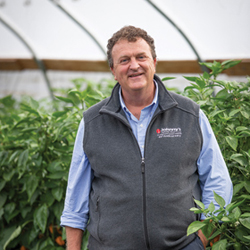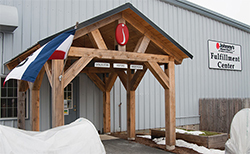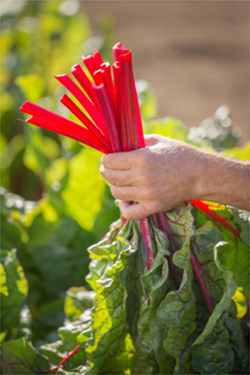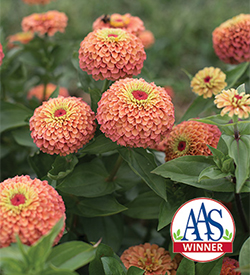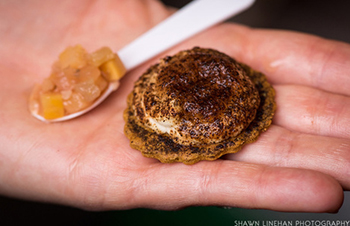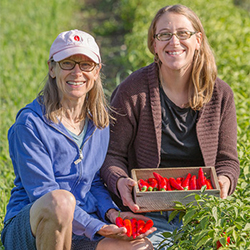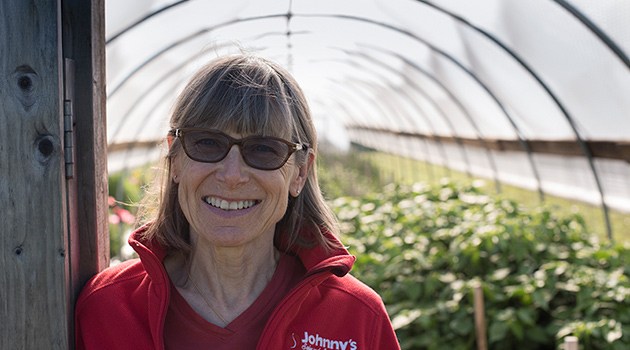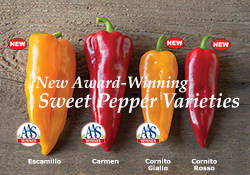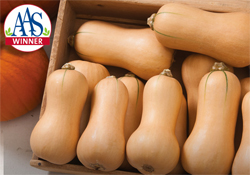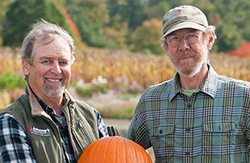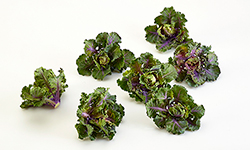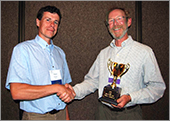Press Releases
An Enduring Commitment to Quality, Innovation & Service
Winslow, Maine: January 2023 — For 50 years, Johnny's Selected Seeds has been dedicated to helping families, friends, and communities to feed one another by providing quality seeds, tools, information, and service. … Read more
Scientific Leadership & Oversight to Drive Innovation & Growth
Albion, Maine: December 2, 2020 — Johnny's Selected Seeds is pleased to announce the promotion of Kevin Cook, PhD to the position of Vice President of Research & Development. In his new role, Dr. Cook will be leading Johnny's product innovation and will oversee product selection and trialing, breeding, seed production, and quality assurance. … Read more
Employee-owned company builds equity in hard asset
Fairfield & Winslow, Maine : December 3, 2019 — Johnny's Selected Seeds has purchased its warehouse and office building after leasing the space from the Town of Winslow for many years … Read more
Classical Plant Breeders Produce a More Bolt-Resistant, Refined Strain of Red Chard
Albion, Maine : January 3, 2018 —Swiss chard is both a commercial staple and a home garden favorite, but it can be susceptible to bolting, which means the plants put on flowers and set seed. Once greens like chard bolt, their flavor degrades, and they are no longer marketable.
Of chard types, 'Rhubarb' chard — with its beautiful red stems — is "notoriously early to bolt," says Dr. John Navazio, Johnny's Selected Seeds plant breeder. Navazio wanted to create a more bolt-resistant strain of 'Rhubarb' chard that would excel in organic growing systems and maintain vibrant and uniform red stems and green leaves… Read more
2018 AAS Award Winner with Stunning Colors
Albion, Maine : January 3, 2018 — Of the 30+ new flower varieties that Johnny's Selected Seeds is offering this year, 'Queeny Lime Orange' zinnia is one of the most exciting. It is a 2018 All-America Selections Committee (AAS) award winner, and it is easy to see why — 'Queeny Lime Orange' has striking coloration, with glowing apricot blooms that feature a blush of lime and bright rose centers… Read more
Johnny's-Bred 'Tempest' Is a Culinary Star
Albion, Maine : December 4, 2017 — The classical plant breeding team at Johnny's Selected Seeds announces the release of its third Johnny's-Bred summer squash! The yellow crookneck squash, called 'Tempest,' was bred by Janika Eckert specifically for organic growers. It offers an excellent, buttery flavor; a firm texture that stands up well through a multitude of cooking methods, from grilling and roasting to pickling and braising; and a unique, vibrant yellow color with distinctive ridges and subtle striping.… Read more
Johnny's-Bred 'Red Ember' Cayenne Pepper & 'Valentine' Grape Tomato Selected as Winners
Albion, Maine : November 15, 2017 — Johnny's Selected Seeds has won two more All-America Selections Committee (AAS) awards for its 'Red Ember' cayenne pepper and 'Valentine' grape tomato. Including these newest awards, Johnny's classical plant breeding team now has 12 AAS awards under its belt!… Read more
–Janika Eckert, Johnny's Plant Breeder
For Classical Plant Breeder at Johnny's, Patience Has Its Reward
Madison, Wisconsin : August 27, 2016 — Johnny's Plant Breeder Janika Eckert was awarded the All-America Selections (AAS) Breeder's Cup at the annual summit held in Madison. Eckert has produced four AAS-winning varieties: 'Diva' spineless sweet cucumber, in 2002; 'Carmen,' an early sweet red Italian pepper, in 2006; 'Escamillo,' an early sweet golden Italian pepper, in 2016; and 'Cornito Giallo,' a half-size sweet golden Italian pepper, in 2016.
Curious as to why so many award-winning vegetable varieties come from the fields of this small, but thriving seed company in Central, Maine, we were recently given the rare chance to peel the onion, so to speak, on breeding at Johnny's in an interview with Eckert… Read more
with AAS-Winning Qualities
—Janika Eckert, Award-winning Plant Breeder
Albion, Maine : November 2015 — Johnny's has done it again — receiving two All-American Selections National Awards in recognition of its newest Corno di Toro pepper varieties. In addition to being chosen for their outstanding flavor and rich coloration, Johnny's AAS-winning peppers are easy to grow under a wide range of conditions, mature early, and express a compact, upright growth habit, or "plant architecture" that keeps the fruits healthy and up off the ground.
Corno di Toro, or "bulls-horn" peppers, have become an important class for market growers, in large part thanks to 'Carmen.' According to Emily Haga, plant breeder for Johnny's, " 'Carmen' is a sweet, red Italian frying pepper bred by Johnny's that has an almost cult-like following among pepper growers and lovers. Everywhere I go, people grow this 2006 AAS award-winner and love its dependability and flavor. This year, Johnny's Selected Seeds is expanding its selection in this important category, with AAS Winners 'Escamillo,' and 'Cornito Giallo'…." Read more
— Pete Zuck, Johnny's Product Manager for Squash
Albion, Maine : November 2014 — The All America Selections Committee has chosen 'Butterscotch,' the newest butternut variety developed by Johnny's traditional breeding team, as a 2015 National AAS Vegetable Winner…
...Butterscotch is the eighth AAS Winner chosen from more than 50 new vegetable varieties introduced by the powerhouse team over the years. [Rob] Johnston's lifelong contribution to the world of horticulture was underscored by his being awarded the prestigious Breeders Cup at the 2013 All-America Selection Summit.… Read more
Albion, Maine : October 2, 2014 — Johnny's Selected Seeds warmly welcomes Dr. John Navazio, veteran plant breeder, agroecologist, author, and organic seed production specialist as manager of its plant breeding program. Dr. Navazio is a natural fit for Johnny's, renowned for its prodigious introduction of traditionally bred, award-winning new crop varieties to direct-market growers and avid home gardeners….
With a career path that clearly aligns with Johnny's long-term breeding goals, Dr. Navazio sees "an incredible opportunity in taking on the landmark traditional breeding work led for over four decades by Rob Johnston," Johnny's founder and CEO. "Some of North America's most important crop germplasm is being housed and developed right here in Central Maine.…" Read more
Fairfield, Maine : September 2014 — Lauded by foodies as the "new kale," Kalettes® are the striking result of a non-GMO cross between kale and Brussels sprouts. Johnny's Selected Seeds is pleased to introduce the new Kalettes seed this fall to direct-to-market commercial growers and avid home gardeners across the US and Canada, under an exclusive partnership with Tozer Seeds…. Read more
Burlington, Ontario, CANADA : August 2013 — ll-America Selections (AAS) hosted their annual Summer Summit August 12–14 this year in Ontario, Canada. Rob L Johnston, Jr, Founder and Chairman of Johnny's Selected Seeds, was selected by the AAS Board of Directors to receive the 2013 Breeders Cup. The AAS Breeders Cup Award recognizes someone who has had a significant impact in horticulture by breeding stand-out varieties.
Rob's contribution to the world of horticulture includes helping produce varieties that in diverse climates have outstanding flavor, disease resistance, and garden performance. Under Rob's leadership, the Johnny's breeding team has introduced more than 50 varieties. Seven of these Johnny's-bred varieties have been honored with the prestigious All-America Selections award…. Read more
Fairfield, Maine : April 12, 2013 — For 50 years, the Mid-Maine Chamber of Commerce has bestowed awards on distinguished area businesses and business people at their Annual Awards Dinner. We're pleased to announce that Michelle Lepage, Johnny's Selected Seeds' Customer Experience Manager, is the 2012 recipient of the Mid-Maine Chamber of Commerce Customer Service Stardom Award… Read more
The Ultimate Efficiency Lettuce
Fairfield, Maine: April 2013 — Salanova is the newest innovation in lettuce for the salad mix market. Taking over 20 years for breeders to develop, Salanova's unique core structure allows fully mature, compact heads to be easily cut into individual uniform leaves. Because the heads are allowed to reach full size, they produce fully-developed flavor, texture, and color compared to baby leaf. For the first time, this line is available from Johnny's Selected Seeds to U.S. and Canada small, direct-market growers.
Praised for its versatility, efficiency, and yield, Salanova offers many benefits for the grower. Salanova provides high yields at lower-cost… Read more
- Selection at Johnny's: The Story of Sugar Ann
- How We Trial & Select Superior Greenhouse Performers
- Johnny's Carrot Growing Guide
- Weed Management in Sustainable Agriculture
- Johnny's Winter Growing Guide
- 5 Recently Introduced Johnny's-bred Varieties
- Principles & Practices of Succession Planting
- Prevent Resistance Buildup in Pests & Pathogens



